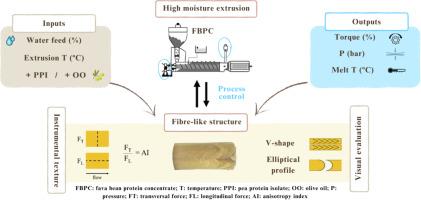Fibre-like structure formation in fava bean protein based extrudates: effects of extrusion inputs and potential of outputs for process control
IF 8.2
Q1 FOOD SCIENCE & TECHNOLOGY
引用次数: 0
Abstract
High moisture extrusion processing (HMEP) is a complex process in which product formulation and extrusion conditions play a key role in fibre-like structure formation. The aim of this work was to study the effect of process input parameters (formulation, liquid feed, and extrusion temperature) on the texture development of a high moisture extrudate (HME) based on fava bean protein concentrate (FBPC), combined with a different protein source (pea protein isolate - PPI) or an oil ingredient (extra virgin olive oil (EVOO)). The influence of extrusion outputs (melt temperature, pressure, and torque) on texture parameters and its potential to control the texturisation process was also investigated. Formulation (protein source and added oil) and moisture content had a significant effect on textural characteristics of HME, while a variation of barrel temperature of 10 °C (from 145 to 155 °C) was not sufficient to influence the final product texture. Addition of PPI to FBPC-based HME increased hardness and fibrousness of the product, while oil addition had a lubricating effect which difficulted the formation of fibre-like structures in the direction of the extrusion flow. Out of the studied extrusion outputs, torque was highly correlated with the HME textural characteristics, showing potential for inline control of the HMEP process.

蚕豆蛋白基挤出物中纤维状结构的形成:挤出输入的影响和过程控制输出的潜力
高水分挤压加工(HMEP)是一个复杂的加工过程,产品配方和挤压条件对类纤维结构的形成起着关键作用。本研究的目的是研究工艺输入参数(配方、液体饲料和挤出温度)对以蚕豆蛋白浓缩物(FBPC)为基础,结合不同蛋白质来源(豌豆分离蛋白- PPI)或油成分(特级初榨橄榄油(EVOO))的高水分挤出物(HME)的质地发展的影响。挤压输出(熔体温度、压力和扭矩)对织构参数的影响及其控制织构过程的潜力也进行了研究。配方(蛋白质源和添加油)和水分含量对HME的质地特性有显著影响,而桶温变化10℃(从145℃到155℃)不足以影响最终产品的质地。在fbpc基HME中添加PPI提高了产品的硬度和纤维度,而添加油具有润滑作用,难以在挤出流动方向上形成纤维状结构。在研究的挤压输出中,扭矩与HMEP的纹理特征高度相关,显示出HMEP过程的在线控制潜力。
本文章由计算机程序翻译,如有差异,请以英文原文为准。
求助全文
约1分钟内获得全文
求助全文
来源期刊

Future Foods
Agricultural and Biological Sciences-Food Science
CiteScore
8.60
自引率
0.00%
发文量
97
审稿时长
15 weeks
期刊介绍:
Future Foods is a specialized journal that is dedicated to tackling the challenges posed by climate change and the need for sustainability in the realm of food production. The journal recognizes the imperative to transform current food manufacturing and consumption practices to meet the dietary needs of a burgeoning global population while simultaneously curbing environmental degradation.
The mission of Future Foods is to disseminate research that aligns with the goal of fostering the development of innovative technologies and alternative food sources to establish more sustainable food systems. The journal is committed to publishing high-quality, peer-reviewed articles that contribute to the advancement of sustainable food practices.
Abstracting and indexing:
Scopus
Directory of Open Access Journals (DOAJ)
Emerging Sources Citation Index (ESCI)
SCImago Journal Rank (SJR)
SNIP
 求助内容:
求助内容: 应助结果提醒方式:
应助结果提醒方式:


